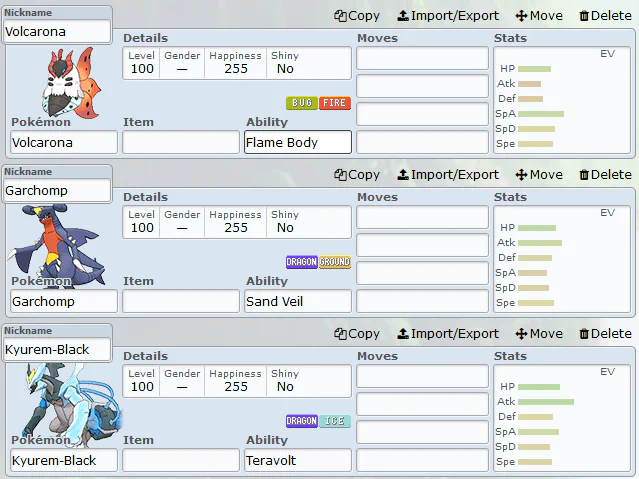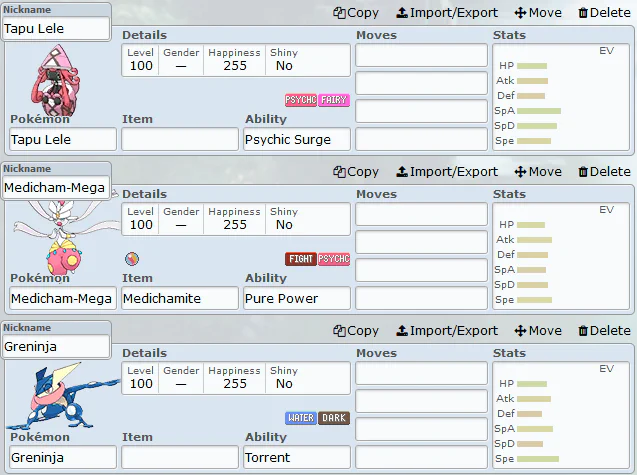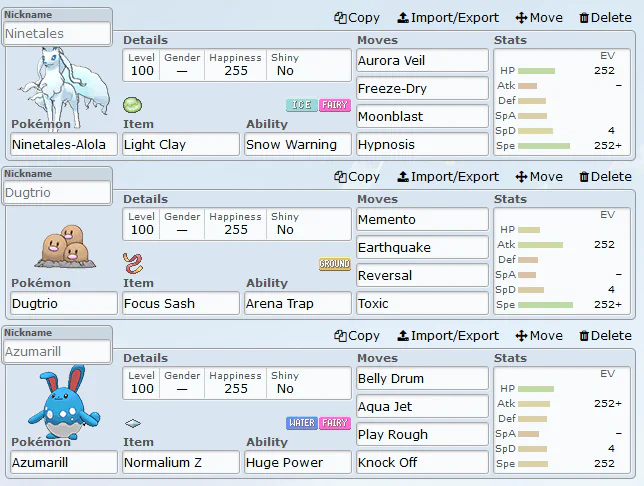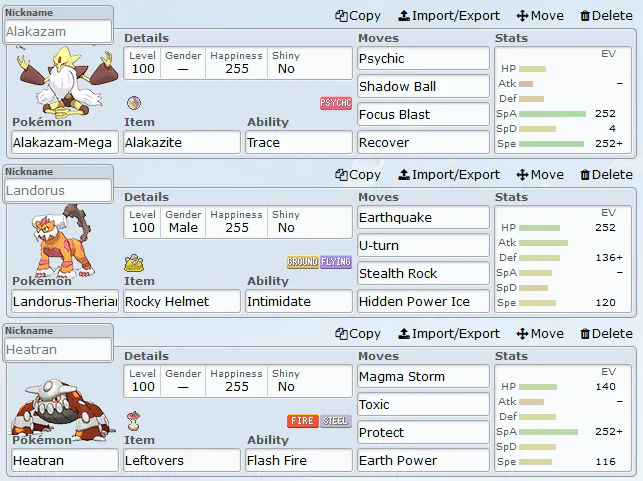An Introduction
Hello! My name is Spader. I have been playing Pokemon at the highest level of singles play for about ten years now (albeit less active recently). You may know me on Smogon as user: Bad Ass (bonus: an interview I don’t remember in the slightest1). I play virtually every tier in existence, and love almost all of them! I don’t have as much time to invest in the game as I would like, but I’ve noticed there is a lack of guides on improving at Pokemon (as opposed to fighting games, where theory and strategy are overflowing on the internet). This will be a series of articles to help you improve at the game.
This guide is: a collection of knowledge, game theory, decision making strategies, and simple but effective ways of improving. I’ll assume that you have mastered the mechanics of the game (which you probably did as an 8 year old), and have been playing competitively for perhaps a few months. This series will cover things such as:
- How to form and execute a gameplan
- How to construct a solid, purposeful team
- How to make better predictions
- Maximizing your odds
This guide is not: An overview of the current metagame; a repository of good teams; magic; a list of strong Pokemon or sets. It’s also not a rail against creativity, or a dictum that one must use only S-tier, top ranked Pokemon. A top level tournament player would thrash most mid tier ladder players with a team of UU Pokemon. But, if you want your cool and weird team idea to work, you need to back it up well!
Here is part one of the series.
Part 1: Bringing a Solid Team
part 1.1: cover your (non-optional) basics
Every game has things that are non-optional. Some are mechanical, and some are more conceptual. If you’re familiar with fighting games, you understand this. You simply have to know your character’s best kill moves and standard combos – they are standard for a reason, namely that they are the best option in many circumstances. This is very plain and unhidden, but very important. You also have to know about spacing and footsies. This idea is more conceptual; it’s not about a simple single decision (click kill move), but rather about all the things that could happen in the near future. Both are non-optional if you want to be good at fighting games though!
So, in Pokemon, here are some good mechanical things to cover when making a team. You can treat this like a checklist when making a team! I’ll discuss them more after I list them.
- You have to bring Stealth Rock. I have (and I’m not exaggerating here) never brought a team without it on purpose.
- You need to have a way to actually win the game (also known as a win condition)
- You need to have a way to force out or revenge kill things which are fast and strong.
- You need to have a way to force out or kill things which are bulky and use stat-boosting moves.
- You need to not instantly lose to any of the top (for example) 25 most common Pokemon
When you enter higher levels of play, the way you accomplish these things becomes much more nuanced, but the need to do these things remains constant. That’s why they’re really important! Let’s go through them.
stealth rock
Stealth Rock is the best move in the game, and has been since it was created in DPP (Diamond/Pearl/Platinum). If you haven’t seen them before, they are an entry hazard that is used once, and then deals 12.5% * [your weakness to rock here] damage on switch.
They prevent defensive teams from being able to switch to a counter every time you attack, which I’ll talk about more in the momentum section. They also rack up damage that you will find comes in handy surprisingly often for eking out KOs. They are also extremely important in checking some dangerous pokemon – Mega Charizard, Dragonite, Tornadus-Therian, and Gyarados are all examples of sweepers which become much more dangerous without Stealth Rock to chip away at them. They are not negotiable. Make sure exactly one Pokemon on your teams uses Stealth Rock.
If you think that Stealth Rock is not good because not many top tier Pokemon are weak to Rock, well, why do you think Rock weak Pokemon aren’t top tier in the first place?
win conditions
This is the most important thing that new players miss. If you put together a team of six fat, bulky Pokemon that don’t deal damage, you will lose the game. If you put together a team of six wild sweepers with no sense of their meshing as offensive tools, some dude is gonna come along with his well put together balance team and hit as hard as you while actually being able to take a punch. And you will lose. Not having an explicit win condition means that your win condition is hoping the other person loses the game. You hear this a lot in games. When you’re new, it can be frustrating, since it’s not really clear what things like ‘win condition’ really mean. I’ll go over what a win condition looks like in Pokemon, and how to pick a good one in the section about having a plan.
revenge killers
The opponent will have Pokemon that are fast and strong, or else Pokemon that boost one of their stats to become fast and strong. The point here is that you will be facing down the barrel of a Pokemon which outspeeds most of your team and has the tools to dispose of them. For this, we need a revenge killer. The term originates from the idea that when the opponent kills something with their big strong sweeper, you can use your free switch to send in something faster and take it out in revenge.
Of course, it’s not quite that easy in practice. The opponent can always switch their sweeper out after you send your revenge killer in. Even if they leave their sweeper in to faint, there is a good chance they will use the free switch next turn to do something dangerous. However, either of these options is preferable to the alternative (i.e. the opponent’s sweeper beats your team). Usually a revenge killer will use a Choice Scarf to boost its speed past that of the things it wants to revenge kill, but you can also use a naturally fast Pokemon (for example, Mega Alakazam). The tradeoff here is that Pokemon that are fast enough to not need a Choice Scarf are usually frail, and are often unable to switch directly into sweepers, relying on a free switch after a faint. The best candidates for revenge killers have these qualities:
- Reasonably fast (counting your boosted speed if you’re using a Choice Scarf). You don’t want to be slower than what you are revenging!
- Reasonably bulky, or resist many of the moves of the things you want to revenge kill. This allows you to not have to strictly make a sacrifice to take out an opponent’s threat. A good example of this is Landorus-Therian. It is immune to Ground and resists Fighting moves, and Intimidate allows it to swap in on many other physical attacks.
- Good coverage moves. Your revenge killer probably isn’t going to be that strong, and since they almost always pack a Choice Scarf, you can’t use any attack boosting items. If you want to revenge kill things well, you need to pack moves which can hit a lot of sweepers super effectively.
- Access to U-turn or Volt Switch. These moves open up a wide, wide array of options that beat the normal drawbacks to revenge killers (namely that you are a sitting duck after the revenge). We’ll go over this more in the momentum section
These qualities exist as a tradeoff. It is very rare to find a Pokemon that satisfies all of these. Think of which ones your team needs (e.g. can you skimp on revenge killing an ultra fast threat and use a bulkier but slower revenge killer that can use U-turn?)
phazers, etc.
Phazing is a very old term that means pseudo-hazing. It used to refer to Pokemon who used Roar or Whirlwind, but has come to mean any method of beating slow, bulky boosting Pokemon2. These Pokemon are very common. Clefable, Mega Latias, Gliscor, Mega Slowbro, and Suicune are excellent examples of them. They thrive against bulkier teams that don’t have the power to force them out, and they are generally resilient against status moves. Some common methods of phazing include: Pokemon with Taunt (stop them from boosting or healing – make sure your Taunt user can take a hit), actual phazing (Roar, Whirlwind, Dragon Tail), Pokemon with Haze (removes all stat boosts; turns bulky stat boosting Pokemon into useless blobs), your own bulky stat booster (make sure that your booster beats the one you need to check!), and the move Knock Off (removing Leftovers makes these Pokemon much easier to deal with, but is not a full solution).
metagame coverage
This is simple, but often violated by low level players. This section is not telling you to be STRONG against every high level threat. That is not really possible. Rather, when you finish a team, scour through the most common Pokemon in your tier and make sure that if the opponent has one in team preview that you at least have a shot.
part 1.2: make high-level strategic plans
You cannot know your opponent’s team before the battle. This is the ultimate case of mutual lack of information in the game – before the game, no player has the advantage (or can have the advantage). That’s why making a team feels very different from the actual playing aspect of the game! In game success depends heavily on reads and inference; sharp, precise things. But team building relies much more heavily on metagame knowledge, and broad strokes of what may happen rather than what is happening.
This lack of information immediately gives rise to rule number one of team building, numero uno, the grand rule which shall at all times be obeyed so he sayeth now and sayeth forever: Your team needs to have a plan, but can never tunnel vision on it.
Before we unpack what that means, let’s start with the easiest example: A team with no plan whatsoever.
 |  |
Now, let’s look at what it means to tunnel vision on a plan.

Here is an example of having a plan, but focusing your team too hard on it: You think Belly Drum Azumarill is a really cool Pokemon (which it is!). But you know that cutting half of your health is very risky – it requires setup. So first, maybe you add a Pokemon to set up Light Screen and Reflect, so Azumarill can be really beefy while it sets up. And maybe you also have a Dugtrio with Memento to trap something, drop its stats, and let Azumarill set up. The problem here is that you dedicated half your team to one strategy. This is bad. Pokemon is a very broad game, and there are plenty of elements of luck. There are – easily – two dozen ways that things could go wrong for this team’s strategy. And when they inevitably do, you’re now playing 3 on 6, which you will almost never win.

Here is an example of having a plan, but having some outs in case things go wrong: You think Mega Alakazam is a really cool Pokemon (which it is!). You know it’s really strong, but has trouble switching in, so you add a Landorus-Therian with U-turn to get him some free switches. Maybe you add a Magma Storm Heatran to trap Chansey and break down special walls. Now you have an excellent core which supports Mega Alakazam’s good traits and covers its bad ones. The difference here is that the things you’ve chosen to do that can pull double duty. If your Alakazam faints early in the match, Heatran and Landorus-Therian aren’t useless – far from it, in fact.
A well-built team has several mutually coherent plans that interlock with each other, and never places all the marbles on one (except in rare, gimmicky situations). When you look at pro’s teams, ask yourself: How do they hope to win the game?
part 1.3: maintain momentum
Momentum is a very nebulous term in games. In Pokemon, you can boil it down to this: When a Pokemon keeps momentum out, it will tend to nudge the game in your favor at every turn. Let’s unpack this by looking at a Pokemon that keeps momentum well, and one that keeps momentum poorly.

Ferrothorn is by its nature a defensive Pokemon. It commonly uses a lot of support moves paired with only a single attacking move. However, Ferrothorn has been one of the consistently best Pokemon in the game since its inception, and fits on nearly every team archetype. Why?
The answer is because it viciously satisfies the principle that we stated above. Let’s think of a few ways your opponent can try to gain advantage, and how Ferrothorn nudges those turns in your favor. The most common ways to gain an advantage on any given turn are:
- Using U-turn to cover both staying in and switching
- Hard switching out to a counter
- Using an attack
Let’s start with U-turn. Normally, U-turn is an excellent option to be able to freely react to your opponent without having to make a read. It is the definition of a momentum maintaining move – many times, no matter what the opponent does you will turn the position heavily in your favor. Ferrothorn’s ability, Iron Barbs, means that when you bring it in on a U-turn, the opponent takes 12.5% damage. It’s bulk means that U-turn’s low power will almost always barely dent it – on the order of 15% to 20%. Without Ferrothorn, the opponent would get a completely free switch to an advantageous matchup, with no drawbacks. Now, if just Stealth Rocks are in play, they are taking 25% damage on one of their Pokemon in order to use U-turn and get the good matchup. That, my friends, is momentum.
Spikes are a massive boon to momentum, for what I hope should be obvious reasons. They put your opponent on a timer, and force them to make their move quickly before their threats are worn down. Even a single layer of Spikes turns all three situations in your favor.
Finally, Leech Seed. If Ferrothorn is against something non-threatening, it can use Leech Seed to hit the switch with impunity. After a Protect and two rounds of Leftovers, you’ve gained around a third of your health back while the opponent has lost (hazards not included!) a quarter of theirs. That’s massive! For other Pokemon, the only way to counter the opponent hard switching is to use a risky double switch. Ferrothorn, on the other hand, can use an incredibly safe Leech Seed to cover the hard switch and guarantee to keep momentum. That’s beautiful.
Here are some other ideas for how your team can keep momentum:
 stealth rock / spikes
stealth rock / spikes 
The single most important way to keep momentum. It’s been mentioned a few times in this article, but that’s because it’s just so dang important. If you have Stealth Rock and one layer of Spikes up, your opponent is taking a quarter of their health any time they switch.
Switching is both one of the most fundamental moves in the game and the most powerful. A good switch can instantly nullify your advantage state. You can be winning one turn and be forced to lose a Pokemon the next. Hazards turn switching from being a borderline overpowered play to one with actual tradeoffs – nudging the game into your favor at each turn.
 leftovers
leftovers 
Leftovers is the best item in the game (Mega Stones, Z-rings, and other gimmicky nuke items notwithstanding). Some of you have probably heard that, but have you ever thought why that is so? After all, a mere 1/16th lifegain per turn seems underwhelming.
The answer is that passive lifegain and passive damage are at the core of keeping momentum defensively. Passive lifegain allows you to waste less turns healing, and puts pressure on your opponent to act lest you undo the damage they just did. And while Leftovers’ recovery feels small, it’s the difference between walling three hits from a wallbreaker instead of two. It’s the difference between a Ferrothorn at half health, still a threat, and a Ferrothorn at a quarter health, nothing but mere fodder. It enables countless situations which nudge the game slightly in your favor.
 u-turn / volt switch
u-turn / volt switch 
U-turn and Volt Switch are certainly in the top 3 moves in the game. They have received nerfs (Iron Barbs, Rough Skin, Rocky Helmet, Regenerator), but they are still moves made of pure momentum. The reason that they’re so suited to momentum is that when a Pokemon with one of these moves is on the field, the next turn is heavily in your favor.
If you can KO the opponent, they will need to make a hard read that you will use U-turn instead of your KO move. That’s very risky, and will turn out in your favor 8 or 9 times out of 10.
If you can’t threaten the opponent, you can make a switch to something that can, and – here’s the kicker – they can’t predict it. If they try to switch pre-emptively, it will happen before your move, and you can switch out after them.
Good candidates for these moves are:
- Defensive Pokemon who you don’t want to be exploited (e.g. Landorus-T, Rotom-W, Zapdos)
- Choice Scarf users, who will bluff a revenge KO and use one of these moves instead (e.g. Landorus-T, Greninja)
- Pokemon with STAB on these moves (e.g. Tapu Koko, Scizor, Rotom-W)
- Strong offensive Pokemon with an extra moveslot (e.g. Greninja, Victini, Tornadus-Therian)
 rocky helmet
rocky helmet 
Rocky Helmet is a fantastic item. It performs the exact same role that Iron Barbs does on Ferrothorn. It’s there to drastically nerf U-turn, and to put pressure on strong physical hitters so that they don’t wear down your walls with no scuffs to show for it.
 regenerator
regenerator 
Regenerator is truly an amazing ability. It, like Leftovers, allows your walls to pressure with moves like Sleep Powder, Thunder Wave, Knock Off, Leech Seed, etc. while still getting their health back. The operating idea here is that the two or three turns you’d waste healing per game are open to actually trying to win the game – that may not sound like much, but remember the principle of the nudge.
 status
status 
Damaging status moves like Toxic and Will-o-Wisp put each turn slightly more in your favor by tacking on extra damage. Similarly to entry hazards, they prevent the opponent from abusing switching and defensive play and forces them to show their hand.
Thunder Wave is exceedingly good because a paralyzed Pokemon is always a liability. You never know when full paralysis is going to kick in – maybe when you were trying to get a hit off on a dangerous sweeper, or catch a switch to a strong threat. It also completely cripples most sweepers and wallbreakers. It’s hard to nudge the battle in your favor more than your opponent saying peace out for a full turn.
And finally, sleep. Sleep has gone from obscenely broken (RBY, BW) to only mostly broken (DPP, ADV) to only kinda-sorta broken (GSC, XY, SM). Remember how generating free turns is one of the most powerful ways of giving yourself momentum? Sleep’s entire mechanic is that you just get a couple of free turns. Yeah.
your team should have a plan but not tunnel vision on it broad plans are the best. focus on how none of these plans place extreme importance on 1-2 pokemon. multiple ways to win. common plans: overload common checks (boosting, techs) broad defensive core + breakers hazard spam, status spam cheese make sure that your team can maintain momentum regenerator stealth rock (special section on this) rocky helmet / iron barbs voltturn taunt status on defensive pokemon in general, plan against archetypes, not individual pokemon heavy offense balance semi-stall hard stall
Resources
The Smogon OU subforum. While top level players don’t hang around here too much, there is plenty of discussion that you as a mid to mid-high level player will benefit from. Of note are the viability rankings (which you should not take literally, but rather use as a basic overview of what is popular), the speed tiers, sample teams, and metagame discussion threads. All of these are stickied. If OU is not your poison of choice, there are similar threads in every other tier’s subforum.
The Pokemon Showdown replay database. Watching other people (or yourself) play is very good for growth! Do it!
smogtours. This is where tournament players play their matches. Even watching them play friendlies can be very educating, and watching tournament matches with chat is always fun.
The Smogon Tournaments subforum. If you don’t know which players are good, or what’s being used at high level, check here. Each trophy tournament has its own subforum where you can find replay threads going back several years. These replays are ridiculously useful, since it is the best players in the world playing at their absolute best.
https://www.smogon.com/competitor/articles/interview_bad_ass ↩︎
Well, not technically. Phazing still really only means Roar or Whirlwind, but for the purpose of this guide the spirit of phazing is what I’m trying to capture here, so I’m lumping all these techniques together. ↩︎